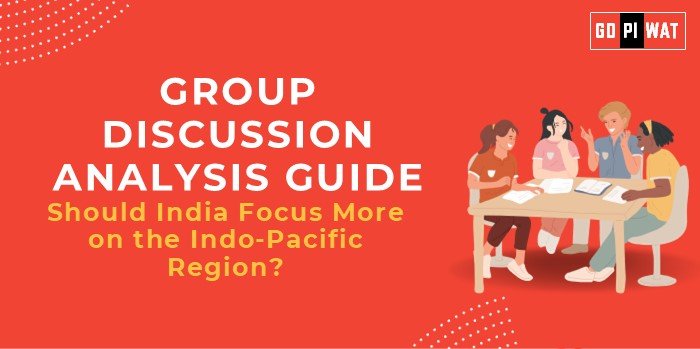📋 Group Discussion Analysis Guide: Should India Focus More on the Indo-Pacific Region?
🌐 Introduction to the Topic
- Opening Context: “The Indo-Pacific region has emerged as a geopolitical and economic fulcrum, hosting major global trade routes, dynamic economies, and escalating strategic rivalries. For India, this region offers immense opportunities but also poses significant challenges in balancing security and growth.”
- Topic Background: The Indo-Pacific concept gained traction with the U.S. “Pivot to Asia” policy and has been championed by countries like Japan, Australia, and India. India’s vision for the region is enshrined in its “Act East” policy, emphasizing inclusive development and strategic partnerships.
📊 Quick Facts and Key Statistics
- 📈 Strategic Trade Routes: Over 50% of the global maritime trade passes through the Indo-Pacific.
- 🌍 Economic Significance: Indo-Pacific accounts for 62% of the global GDP (World Bank, 2024).
- ⚓ Military Presence: The U.S., China, and India have significantly increased naval deployments in the region.
- 🇮🇳 India’s Role: 95% of its trade by volume and 68% by value is seaborne, making the region critical.
🧩 Stakeholders and Their Roles
- 🇮🇳 India: Strengthening naval capacity, securing sea lanes, and fostering economic partnerships.
- 🌏 Regional Nations (Japan, ASEAN, Australia): Collaborating on trade, security, and infrastructure projects.
- 🌐 Global Powers (USA, China): Balancing power dynamics, promoting respective strategic visions.
- ⚖️ International Organizations: Promoting rules-based maritime order (e.g., UN, Quad).
🏆 Achievements and Challenges
- 🌟 Achievements:
- Economic Engagement: Enhanced trade agreements with ASEAN and free trade pact negotiations with Australia.
- Security Initiatives: Increased Quad cooperation and successful maritime exercises like Malabar.
- Infrastructure Investments: Development of Chabahar Port and connectivity projects.
- ⚠️ Challenges:
- Chinese Dominance: Aggressive territorial claims and Belt and Road Initiative influence.
- Economic Constraints: Limited budget for large-scale Indo-Pacific engagements.
- Regional Complexities: Diverse political systems and interests complicating consensus.
🔍 Structured Arguments for Discussion
- ✅ Supporting Stance: “Focusing on the Indo-Pacific aligns with India’s strategic and economic goals, allowing it to secure trade routes and counterbalance China.”
- ❌ Opposing Stance: “India risks overextending its resources, potentially neglecting immediate domestic and regional issues.”
- ⚖️ Balanced Perspective: “A calibrated Indo-Pacific focus, balancing security and economic objectives, aligns best with India’s long-term interests.”
💡 Effective Discussion Approaches
- 📜 Opening Approaches:
- Use a data-driven start: “50% of global trade and 62% of GDP make the Indo-Pacific crucial for India’s growth.”
- Pose a question: “Can India sustain its growing role in the Indo-Pacific without compromising domestic priorities?”
- 🎯 Counter-Argument Handling:
- Acknowledge: Address the slower pace of India’s infrastructure investments compared to other nations.
- Rebuttal: Emphasize India’s focus on sustainable and inclusive development as a long-term advantage.
🔍 Strategic Analysis: SWOT
- 📈 Strengths: Geographic advantage, growing naval power, strategic partnerships (Quad).
- ⚠️ Weaknesses: Limited infrastructure, economic dependencies.
- 🌟 Opportunities: Leadership in Quad, economic diversification.
- ⚡ Threats: Chinese aggression, regional instability.
📄 Connecting with B-School Applications
- 🌍 Real-World Applications:
- Projects on international trade dynamics and maritime security.
- Studies on India’s defense strategy and trade partnerships.
- 💡 Sample Interview Questions:
- “How should India balance its Indo-Pacific strategy with domestic development?”
- “What lessons can India learn from Japan’s Indo-Pacific approach?”
- ✨ Insights for B-School Students:
- Evaluate global trade policies.
- Analyze geopolitical risks in supply chain management.


